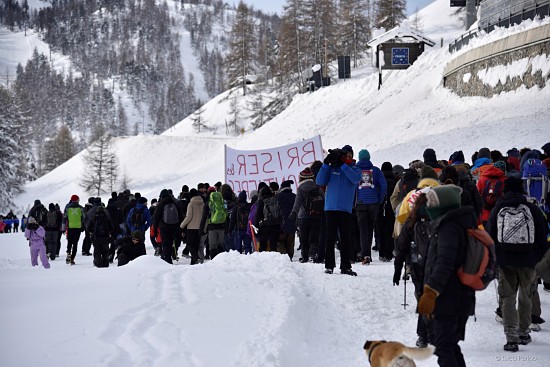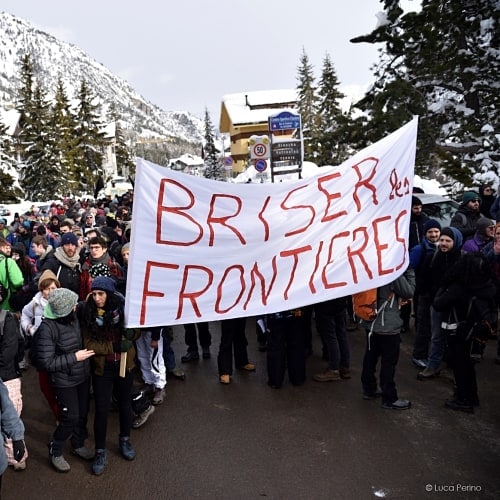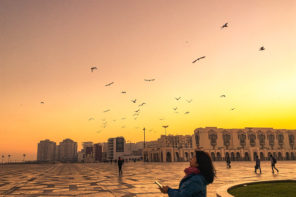While media attention is focused elsewhere, a new phase of the “European border crisis” is unfolding around the snow-covered mountain passes between Italy and France. What might the experience of the African migrants there, and of the activists trying to help them, tell us about the social life of intra-European borders today? This post explores this question, moving in two instalments. Part 1 draws on an encounter with migrants in an Italian border town. Part 2 examines the politics of local pro-migrant activism.
Simona arrives from Claviere. She’s a middle-aged local woman who had never been a political activist, but decided to help the migrants this winter. She’s bringing in her car a married couple from Mali. The woman is clutching a baby girl in her arms. Simona says they are the only ones she managed to persuade not to attempt crossing. The others, eighteen people, left. The Malian couple refuse to leave Simona’s car. Simona explains they are very afraid of being turned in to the police. Franco—the father of one of the young activists I introduced in the last part of these notes—who has temporarily hosted migrants on several previous occasions, tries to persuade them to go sleep at his place. But the couple are extremely mistrustful. Finally, the husband decides to try to see if Franco can be trusted. ‘Are you a Muslim or a Christian?’ he asks him. Franco says Christian, hoping to make it simple. In fact, he’s been an anticlerical communist all his life. ‘Tell me a prayer’, demands the Malian man.
The next day I learn how the story ends. At dawn, the Malian couple demands to be brought back to Claviere like Franco promised. When they arrive, a blizzard is in progress. Franco dials several activists on the French side to come out to the trail at the other end to collect migrants and bring them to safety. The French activists run a shelter in Grenoble that has room for fifteen people but at present is hosting sixty. Nobody answers the phone now, but the Malians are determined to go anyway. Franco, desperate, brings them to the head of the skiing trail, gets back in his car and drives across the border to wait for the couple at the other end. He’s exhilarated when he sees their blurry silhouettes emerge from the falling snow. Just then, though, he also spots the gendarme on patrol up the slope. The gendarme has clearly seen the migrants and he is now rushing to call reinforcements. Franco yells and waves to the Malian couple to speed up. Before the gendarmes arrive, he gets the couple back in the car and rushes to the bus station. Before going to get them tickets, he tells them, in case the gendarmes arrived, to say that he picked them up already in France. The gendarmes must not think Franco has actually carried the migrants across the border. Luckily, the gendarmes never materialize.
The French activists Franco hoped to contact were part of Briser les Frontières (Shatter the Borders), a loose informal network connecting French and Italian activists. The network arose spontaneously, in the final months of 2017, building on previous personal contacts between concerned individuals on either side of the border. Very diverse groups and individuals are involved in the network on the Italian side: from professional Alpine rescuers, to the Waldensians (traditionally present in this part of the Alps), to various (generally left-wing) groups of political activists, to many individual residents with no particular group affinity, like Simona. Val Susa is quite a special place. For over twenty-five years, it has been the site of a struggle against the planned construction of a new transborder high-speed railway (treno alta velocità, TAV). The No TAV movement, having begun from opposing that project, has developed a distinct, place-based multi-faceted critique of neoliberal governance and transnational political economy (in English, see, e.g., Della Porta and Piazza 2008; Armano, Sciortino and Pittavino 2013). Its long history has led to an unusual degree of politicization among the valley’s residents. Many of those now active in Briser are longstanding No TAV activists—such as Franco and the youths with whom I went to Bardonecchia—though the network also thrives on the dedication of many individuals who were never actively involved with the movement.

Photo by Luca Perino
The diversity of backgrounds and outlooks among those making up the network translates into tensions over the network’s goals, modalities of action, and relations with other actors. It is remarkable how the activists are able to work together, negotiating their differences while sharing a fundamental ethical commitment. It is worthwhile, however, to highlight that the network is a difficult process that takes a continuous effort from all those involved. An early controversy concerned collaboration with humanitarian NGOs. For some, the matter was uncontroversial. For others, however, NGOs are essentially ambiguous, seen as complicit with the neoliberal order. For those more politically motivated participants of Briser, it was important to make clear from the start that, as one person put it, they were ‘not volunteers but political activists’. That is to say, their role would not be limited to providing charity aid to the migrants, but it would also centrally involve denouncing the responsibility of the state and the EU for producing the extreme conditions the migrants face. These activists also explicitly question the very legitimacy of national borders as such. In particular, they are critical of the Dublin accords that not only restrict migrants’ mobility and right to asylum but also allow for the violence of arbitrary push-backs. There have also been controversies inside Briser over the forms of assistance to migrants. Some, especially locally based activists familiar with the mountain trails, argue that the only responsible choice is to discourage migrants from attempting to pass the mountains in winter and to try to persuade them to wait until the spring makes the passage safer. Others object to that, arguing that activists must not ‘do the cops’ job’.
Another subject of contention at one point were the relations with local authorities and residents of Bardonecchia. Traditionally, the communes of upper Val Susa, whose affluence derives from the hotel and skiing business, tend to elect right-wing administrations. The mayors of Bardonecchia and Claviere, as well as a majority of local residents, are seen by activists as lukewarm at best, and sometimes openly hostile, to the idea of helping undocumented or ‘irregular’ African migrants. When during a meeting somebody suggested setting up a large tent at Claviere where migrants could at least stay relatively warm, several other activists replied that in their opinion Claviere’s mayor was more likely to set fire to the tent than permit that. This was of course an exaggeration, but it gives an idea of the mutual relations between activists and the local administration. At a time when Rainbow4Africa was negotiating access to a room where the migrants could stay in Bardonecchia, radicals within Briser prepared a flyer they distributed in the town. In no uncertain terms, the flyer denounced the complicity of local authorities, as well as all those enjoying their skiing holidays or profiting from the skiing business, in the violence of the border regime. Some of the locally based activists were concerned that this might jeopardize the tense, fragile, but necessary collaboration with local residents and authorities. ‘Not that they weren’t right’, one of these considerate local activists pointed out to me, speaking of the more radical ones’ action. ‘Much of what they said was very true. But you see how this was just not the smartest move, tactically, at that point.’ This person also drew a delicate distinction between those activists who were firmly rooted in local social relations in Val Susa, and those who had only settled there recently or perhaps retained their base in the radical milieus of Turin or elsewhere. For the latter group, my interlocutor suggested, it might be difficult to appreciate the complexity of local connections, on which the fate of the present and many future struggles would depend. For instance, if you offend a ski-lift operator, you need to take into account, that his wife might be the sister or niece of an Alpine rescuer whose help might prove vital in an emergency. Or, quite mundanely, they might be related one way or another to someone with whom you need to maintain a working relationship possibly for the rest of your life. And, some activists added, even the mayors’ position seems to be changing: not that they have switched to the activists’ (and migrants’) side, but at least they seem to be opening up for dialogue. Indeed, by late March, after activists had occupied a room at the church in Claviere, despite the initial protests by the local parish priest, the bishop conceded that the room be used to offer shelter to migrants and the mayor agreed to pay the utilities—while also making clear that the municipality should not be held accountable for the management of the room.
Given these different positions within the network and challenging external circumstances, the work of Briser les Frontières is an extraordinary feat of activism. Through focus on this work, it is possible to gain insights on the social constitution of the border in contemporary Europe. Recent work in anthropology (e.g., Reeves 2014) has shown how the border is not simply a line on a map or on the ground, but rather a social and material enactment, contingent on the actions of multiple situated actors. Internal borders of the EU have the distinct capacity to fade into insignificance or violently materialize depending on the specific political moment and the identity of the persons attempting a crossing. They’re there and they’re not—hence my designation of the Alpine Italo-French frontier as a blurry border. A focus on the ongoing developments described in these notes additionally allows observing the border as a politically generative terrain of socionatural relations. In addition to spatial depth, as highlighted in the first part of this double post, this terrain also possesses its own distinctive temporal rhythms. These rhythms are dictated not only by bureaucratic procedures, but also by climatic and ecological cycles.
The material and climatic features of the mountains—as well as those of the sea—are fundamental to the life and the experience of the border.
Scholarly critiques of the ‘border regime’ presume a degree of institutional coherence, and examine what is seen as paradoxes of policy from that starting point: how is it that European borderwork is apparently simultaneously driven by a humanitarian ethic of care and a violent, racist imperative of ‘Fortress Europe’ (Vaughan-Williams 2015; Fernando and Giordano 2016)? There is definitely tremendous value in these critical approaches. But
it also seems that the border is essentially a heterogeneous, conflictual, messy space produced by an unruly multiplicity of actors: state and international agencies, gendarmes, passeurs, human traffickers, various profiteers, entrepreneurs, co-operatives, as well as volunteers, humanitarian and political activists, and fundamentally migrants themselves.
It is a space of experiments in sovereign power. According to activists, the Gendarmerie’s operations this winter in the zone between Bardonecchia and Grenoble have been arbitrary and unsystematic, trying diverse tactics. Just as I was finishing typing these notes, on 30 March, in what appears an illegal operation a French customs squad invaded the room run by Rainbow4Africa at the Bardonecchia train station. They searched the possessions of the migrants staying there and forced at least one to undergo a urine test. The officers thus breached the very border-as-line in whose name the violence of push-back operations is routinely perpetrated, and challenged the border’s legal construction.
Moreover, the border itself is politically generative. As the experience of Briser les Frontières shows, the border generates unprefigured political relations, novel axes of contention, and unlikely alliances. It becomes a catalyst of political identities and innovative forms of mobilization. At a meeting in mid-February, Briser activists called for the ‘migrant crisis’ to be approached politically in a broader perspective, addressing its politico-economic and ecological root causes, beyond the usual ‘emergency’ frame. They questioned the European border regime as a key factor producing violence, migrant vulnerability and death. Will there be a genuine response on the part of state and European institutions? Or, when the snow melts away and the number of migrants at the Alpine passes grows, will we watch once more the familiar spectacle of militarization?
Works cited
Armano, Emiliana, Pittavino, Gian Luca and Sciortino, Raffaele. 2013. ‘Occupy in Valsusa: The No TAV Movement.’ Capitalism Nature Socialism 24(2):14‑26.
Della Porta, Donatella and Piazza, Gianni. 2008. Voices of the Valley, Voices of the Straits: How Protest Creates Communities. New York: Berghahn Books.
Fernando, Mayanthi and Giordano, Cristiana. 2016. “Introduction: Refugees and the Crisis of Europe.” Hot Spots, Cultural Anthropology website, June 28, 2016. https://culanth.org/fieldsights/900-introduction-refugees-and-the-crisis-of-europe
Reeves, Madeleine. 2014. Border Work: Spatial Lives of the State in Rural Central Asia. Ithaca: Cornell University Press.
Vaughan-Williams, Nick. 2015. Europe’s Border Crisis: Biopolitical Security and Beyond. Oxford: Oxford University Press.
This research was financed by the National Science Centre (Narodowe Centrum Nauki) within the framework of the postdoctoral research grant programme, grant no. DEC-2013/08/S/HS3/00277









